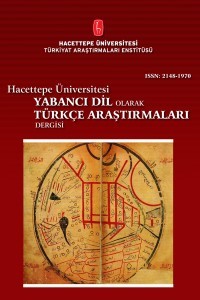
Hacettepe Üniversitesi Yabancı Dil Olarak Türkçe Araştırmaları Dergisi
Yazarlar: ["Selin ALPTEKİN"]
Konular:-
Anahtar Kelimeler:Kanıtsallık,Biçimbirim,Dilbilgisi öğretimi,Kitap incelemesi,Yabancı dil olarak Türkçe öğretimi
Özet: The grammatical category known as evidentiality describes the proposition made by the speaker as well as the pertinent information's source and nature. Different languages have distinct semantic characteristics and marking forms for evidentiality. In Turkish, the source of information is marked grammatically with the morphemes “-mIş” and “-ImIş”. This study examines 5 units from Yeni Hitit Turkish for Foreigners 1, 2 and 3 course books and 2 units from Yedi Iklim Turkish Set A2 and B2 course books prepared by Yunus Emre Institute using the document analysis method to probe the evidential function of the mentioned morphemes in terms of form, meaning, and use. This reseach determined evidential functions of morphemes like "non-witness, uncertainty, indirect experience, doubt, hearsay, rumor, quote, contempt" and established that although in the Yeni Hitit TFF course books the grammar is taught clearly and the emphasis is placed on form, activities however are largely removed from the context. In the Yedi Iklim course books, grammar is implicitly taught while meaning and use are prioritized over form, and tasks are provided in context. Finally, based on these findings, it is evident that meaning, use, and form should all be taken into account in order to fully understand the activities.